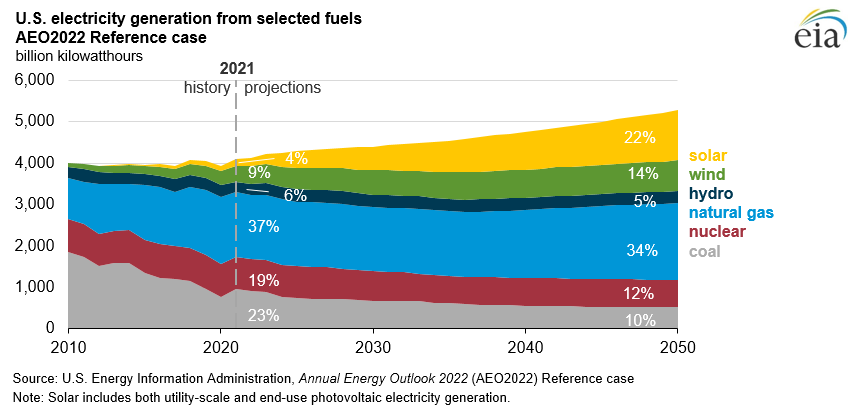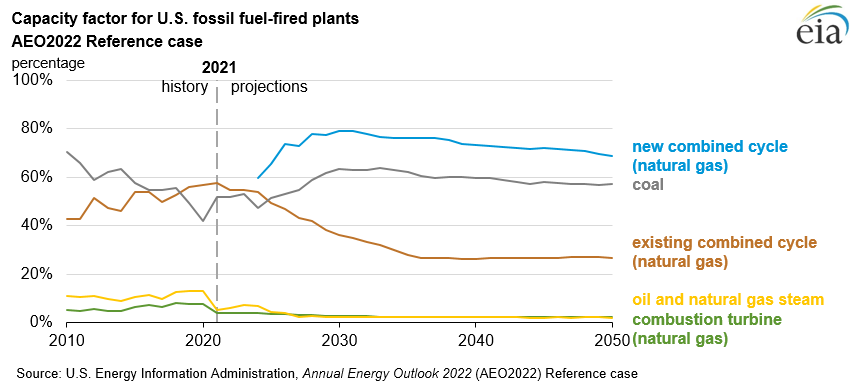
- Electricity demand grows slowly across the projection period, which increases competition among fuels
- Renewable electricity generation increases more rapidly than overall electricity demand through 2050
- Battery storage complements growth in renewables generation and reduces natural gas-fired and oil-fired generation during peak hours
- As coal and nuclear generating capacity retire, new capacity additions come largely from wind and solar technologies
Renewable electricity generation increases more rapidly than overall electricity demand through 2050
Figure 12.

Renewable electricity generation meets incremental demand growth
The share of renewables in the U.S. electricity generation mix more than doubles from 2021 to 2050. Wind grows more than any other renewable generation type from 2021 through 2024, accounting for more than two-thirds of those increases in electricity generation during that period. After the production tax credit (PTC) for wind phases out at the end of 2024, solar generation accounts for almost three-quarters of the increase for renewable energy. In the Reference case, we model existing legislation for the investment tax credit (ITC): solar receives a 30% tax credit through 2024, which then reduces to 26% for projects coming online in 2024 and 2025 before phasing down to a non-expiring credit of 10% starting in 2026.
Sustained low natural gas prices keep natural gas generation at the highest market share in the Reference case
The share of natural gas in the generation mix remains relatively constant, at about one-third from 2021 to 2050. Although the share remains the same, projected natural gas prices stay below $4.00 per million British thermal units (MMBtu) for most of the projection period. The natural gas share remains consistent despite significant projected coal and nuclear generating unit retirements, which cause the shares from those sources to drop by half. Generation from renewable sources increases to offset the natural gas share, largely because regulatory programs and market factors incentivize these sources.
After near-term natural gas prices stabilize, and as more solar and wind energy integrates into the electricity grid, natural gas-fired generating unit capacity factors steadily decrease. The average capacity factor of the coal fleet increases as inefficient units are retired throughout the projection period
Figure 13.

As more wind and solar capacity is added, both existing and new natural gas-fired generation is displaced, and capacity factors for existing combined-cycle units drop by nearly half from a peak of 60% in 2020. Because natural gas-fired generating capacity grows faster than natural gas-fired generation from 2020 to 2050, capacity factors for natural gas units decline steadily across all plant technology types. The average capacity factor of operating coal plants increases over the projection period as relatively old and inefficient coal plants retire and the more efficient and cost competitive plants remain. Natural gas accounts for more than 40% of cumulative capacity additions from 2020 to 2050. About half of natural gas capacity additions through 2050 are low-utilization combustion turbines, which are economically attractive when mostly used to provide infrequent peaking capacity.
Energy storage systems, such as stand-alone batteries or solar-battery hybrid systems, will compete with natural gas-fired turbines as sources of back-up capacity for nondispatchable renewable energy sources. Storage systems can act as an arbitrage tool to move solar and other generation from periods of high supply and low demand to periods of low supply and high demand, and they can provide capacity for grid reliability in times when nondispatchable generation is not available.
-
Figure data
- Electricity figure data
- Note: You can access chart data by right-clicking the chart in the PPT file.
The share of renewables in the U.S. electricity generation mix more than doubles from 2021 to 2050.
-
About the Annual Energy Outlook
- Contact information and staff
- Information on Obtaining NEMS
- Retrospective Review
- NEMS: An Overview (2018) PDF
-
Previous Editions of the AEO
-
-
Documentation and Assumptions